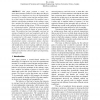70 search results - page 11 / 14 » Multi-Agent Architectures as Organizational Structures |
TSE
1998
13 years 9 months ago
1998
ABSTRACT. This paper presents a novel, scenario-based notation called Use Case Maps (UCMs) for describing, in a high-level way, how the organizational structure of a complex system...
HICSS
2008
IEEE
14 years 4 months ago
2008
IEEE
How does “self-governance” happen in Wikipedia? Through in-depth interviews with eleven individuals who have held a variety of responsibilities in the English Wikipedia, we ob...
AMKM
2003
Springer
14 years 3 months ago
2003
Springer
We first describe a multi-agent system managing a corporate memory in the form of a corporate semantic web. We then focus on a newly introduced society of agents in charge of wrap...
DGO
2007
13 years 11 months ago
2007
Solving complex global problems such as illegal immigration, border control, and terrorism requires government organizations at all levels to share not only data but, more importa...
HICSS
2000
IEEE
14 years 2 months ago
2000
IEEE
Influenced by the linking model which is implicit in HTML, today’s publishing model on the Web is contentcentered, with the emphasis of publishing on content rather than links....

